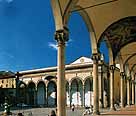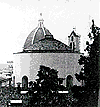
SS. Annunziata
The church stands on the pre-existent oratory of the Servi di Maria (1235)
which was built around the miraculous image of Our Lady of the Annunciation
by seven young noblemen who decided to take monastic vows and give up
worldly pleasures. As a further sacrifice, they later founded the Monastery
of Monte Senario, above Fiesole.Michelozzo built the First Cloister in the mid 15th
century. The main body of the Church, started in 1440 by Michelozzo and Pagno Portigiani, was later altered
by Alberti, who created the impressive Tribune
that can be seen on the righthand side.
Three separate environments can be reached from the plain facade, decorated with
the coats of arms of Pope Leo X dei Medici frescoed
by the young Pontormo : the Chapel dei Pucci
or of San Sebastiano on the right; the large Cloister dei Morti on the left,
with frescoes also by Andrea del Sarto (the
Madonna of the Bag); and the First Cloister or little Cloister dei Voti in
the centre, frescoed throughout by masters of the Florentine Mannerist school
of the early 16th century: Rosso Fiorentino, Pontormo,
Franciabigio e Andrea del Sarto, who painted the face of the Virgin as a really
faithful portrait of his wife, Lucrezia del Fede who apparently, according to Vasari was not faithful at all.

Assumption
by Rosso Fiorentino
The interior of the monument, designed by Alberti but later covered by rich baroque decorations,
consists in a single nave covered by a large cupola. The elaborate Baroque ceiling
was carried out by P.Giambelli on a design by Volterrano (XVII cent.). The side
chapels contain a great many works of art: frescoes by Andrea del Castagno, an Our Lady of the Assumption
by Perugino, a Resurrection by Bronzino, sculptures
by Giambologna and, in the transept, a marble
Deposition by Baccio Bandinelli whose self-portrait can be seen in the face of
Nicodemus in the vault.
Inside, on the left, one can see a little marble temple designed by Michelozzo (1448-61) in honour of the fresco of
the Annunciation; this is still greatly worshipped and is exposed to the
faithful on March 25th (Assumption Day) every year (which was also the date of
the Florentine New Year for many centuries)

Birth of the Virgin
by A.d.Sarto
According to legend, the anonymous artist who painted it fell asleep after
having completed the angel but his sleep was disturbed by his fear of not
being capable of portraying the Virgin better than the angel he had just
painted. When he awoke he was surprised to find that the fresco had been
completed by a supernatural hand. Since popular tradition attributes this
painting with miraculous virtues, young married girls still go to the Church
of the Annunziata immediately after the marriage service to offer their
bridal bouquets to the Madonna of the little Temple.
The face of Christ in the relic is by Andrea del Sarto. Apart from the works mentioned
above, the chapels in the lefthand nave contain the Holy Father with St. Jerome
and the Holy Trinity by Andrea del Castagno, who with rude violence interprets Masaccio 's lesson in perspective at the Carmine.

Tribune of SS.Annunziata
The Cloister dei Morti leads into the Chapel of San Luca, the patron saint of painters, where Cellini, Pontormo, Franciabigio, Bartolini and other masters are buried. Annual exhibitions of painting by contemporary artists were held here in the 16th-18th centuries.
